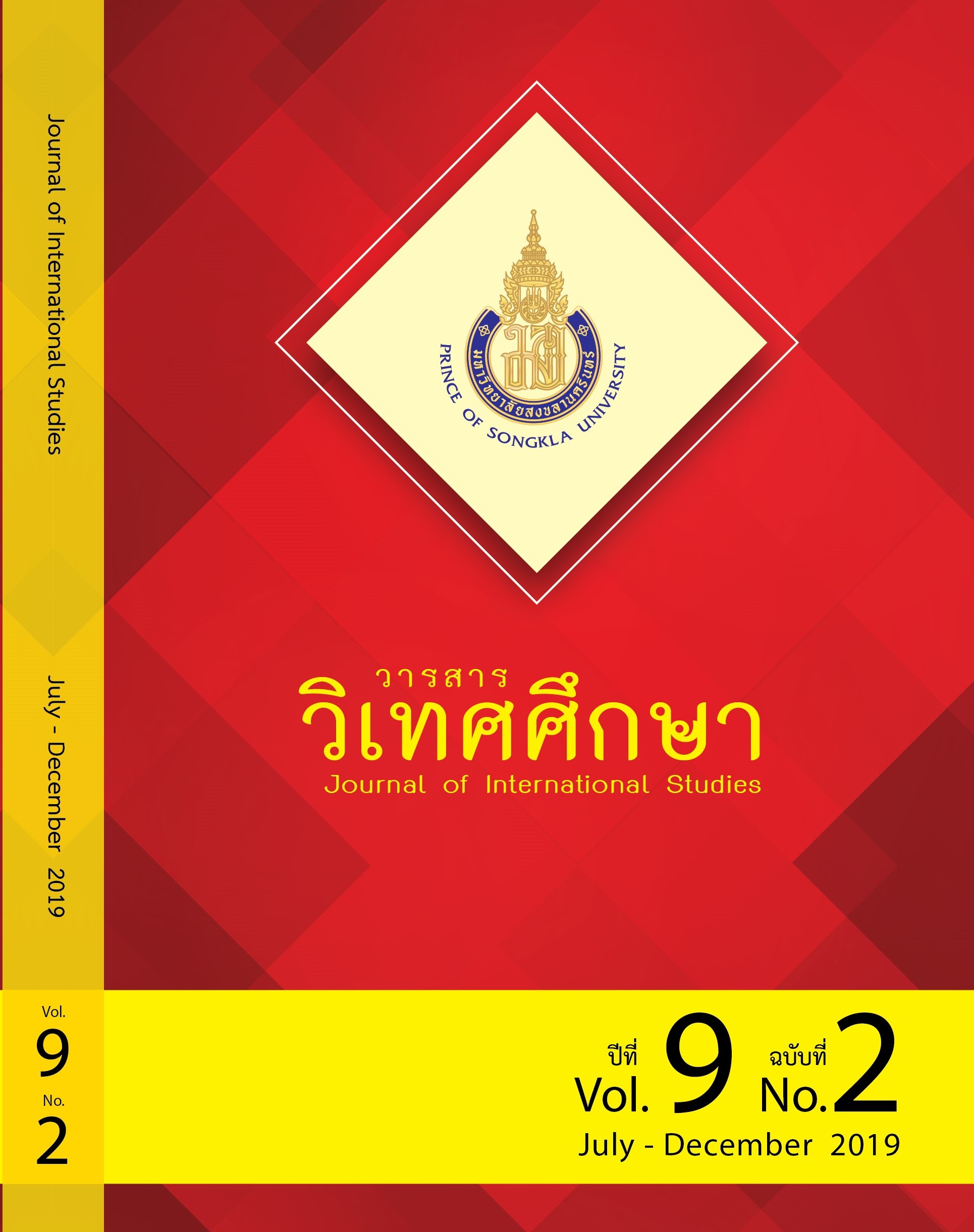การวิเคราะห์ความสำคัญและการดำเนินการของคุณภาพข้อมูลดิจิตอลของแหล่งท่องเที่ยวในมุมมองนักท่องเที่ยวต่างชาติ
Main Article Content
บทคัดย่อ
ข้อมูลดิจิตอลเป็นแหล่งข้อมูลที่นักท่องเที่ยวใช้ในการรวบรวมข้อมูลเกี่ยวกับสถานที่ท่องเที่ยว ปัจจุบันตลาดการท่องเที่ยวมีการแข่งขันสูงคุณภาพของข้อมูลที่นำเสนอต่อนักท่องเที่ยวเป็นสิ่งจำเป็นการทำความเข้าใจความสำคัญและความพึงพอใจของคุณภาพข้อมูลที่นำเสนอในมุมมองของนักท่องเที่ยวเป็นสิ่งจำเป็น ดังนั้นวัตถุประสงค์ของการศึกษานี้ คือ 1) เพื่อระบุจุดแข็งและจุดอ่อนของคุณภาพข้อมูลดิจิทัลของประเทศไทยโดยใช้วิธีการวิเคราะห์ความสำคัญและผลการดำเนินงาน (Importanceperformance analysis: IPA) 2) เพื่อตรวจสอบช่องว่างระหว่างคุณภาพและประสิทธิภาพของข้อมูลดิจิทัล
จากคุณลักษณะทั้งหมด 17 รายการมี 8 รายการที่อยู่ในหมวดที่ 1 “ ทำดีอยู่แล้วทำดีต่อไป” ไม่มีรายการใดอยู่ในหมวดที่ 2 “ ต้องแก้ไขด่วน” มี 8 คุณลักษณะในหมวดที่ 3 “เป็นปัญหารองยังรอได้” และมีเพียง 1 รายการในหมวดที่ 4 “ เป็นประเด็นรองแต่ทำได้ดี” การศึกษาครั้งนี้มีประโยชน์เพราะสามารถระบุประสิทธิภาพและความพึงพอใจในมุมมองนักท่องเที่ยวต่อข้อมูลดิจิทัลของประเทศไทย และสามาถใช้ผลการศึกษานี้ในการปรับปรุงพัฒนาคุณภาพของข้อมูลดิจิตอลให้ดีขึ้น
Article Details
ข้อความและความคิดเห็นที่แสดงในบทความ เป็นแนวคิดของผู้เขียน มิใช่ความรับผิดชอบของกองบรรณาธิการ และคณะผู้จัดทำแต่อย่างใด
บทความ ข้อมูล เนื้อหา รูปภาพ ฯลฯ ที่ได้รับการตีพิมพ์ในวารสารวิเทศศึกษา ถือเป็นลิขสิทธิ์ของวารสารวิเทศศึกษา หากบุคคลหรือหน่วยงานใดต้องการนำทั้งหมดหรือส่วนหนึ่งส่วนใดไปเผยแพร่ต่อหรือเพื่อกระทำการใด ๆ จะต้องได้รับอนุญาตเป็นลายลักษณ์อักษรจากวารสารวิเทศศึกษา ก่อนเท่านั้น
เอกสารอ้างอิง
Bell, R. (2016). A critical evaluation of information sources used in the tourist destination decision making process (Doctoral Dissertation). University of Salford, Manchester.
Bizirgianni, I., &Dionysopoulou, P. (2013). The influence of tourist trends of youth tourism through social media (SM) & information and communication Technologies (ICTs). Procedia - Social And Behavioral Sciences, 73, 652-660. doi: 10.1016/j.sbspro.2013.02.102
Boley, B., McGehee, N., & Tom Hammett, A. (2017). Importance-performance analysis (IPA) of sustainable tourism initiatives: The resident perspective. Tourism Management, 58, 66-77. doi: 10.1016/j.tourman.2016.10.002
Chung, N., Lee, H., Lee, S., & Koo, C. (2015). The influence of tourism website on tourists & behavior to determine destination selection: A case study of creative economy in Korea. Technological Forecasting and Social Change, 96, 130-143. http://dx.doi.org/10.1016/j.techfore.2015.03.004
Daphet, S. (2016). Applying importance-performance analysis to identify competitive travel attributes: An application to regional destination image in Thailand. Journal of Community Development Research (Humanities and Social Sciences), 10.
DeLone, W., & McLean, E. (2003). The DeLone and McLean model of information systems success: A ten-year update. Journal of Management Information Systems, 19(4), 9-30. doi: 10.1080/07421222.2003.11045748
Deng, J., &Pierskalla, C. (2018). Linking importance–performance analysis, satisfaction, and loyalty: A study of Savannah, GA. Sustainability, MDPI, Open Access Journal, 10(3), 704. doi: 10.3390/su10030704
Djeri, L., Stamenković, P., Blešić, I., Milićević, S., &Ivkov, M. (2018). An importance-performance analysis of destination competitiveness factors: case of Jablanica district in Serbia. Economic Research-EkonomskaIstraživanja, 31(1), 811-826. doi: 10.1080/1331677x.2018.1456351
Dwyer, L., Cvelbar, L., Edwards, D., &Mihalic, T. (2012). Fashioning a destination tourism future: The case of Slovenia. Tourism Management, 33(2), 305-316. doi: 10.1016/j.tourman.2011.03.010
Fotis, J., Buhalis, D., &Rossides, N. (2012). Social media impact on holiday travel planning. International Journal Of Online Marketing, 1(4), 1-19. doi: 10.4018/ijom.2011100101
Grewal, D., Gotlieb, J., &Marmorstein, H. (1994). The moderating effects of message framing and source credibility on the price-perceived risk relationship. Journal of Consumer Research, 21(1), 145. doi: 10.1086/209388
Gronflaten, O. (2005). Sources and channels of tourism information: An exploratory study of travellers' Choice of Information Search Strategies (Doctoral Dissertation). Griffith University, Brisbane.
Gros, C. (2012). The influence of social media on consumers during their purchase decision-making process and the implications for marketers (Master’s Thesis). Dublin Business School, Leinster.
Heung, V. (2003). Internet usage by international travellers: reasons and barriers. International Journal of Contemporary Hospitality Management, 15(7), 370-378. doi: 10.1108/09596110310496015
Huang, C., Wang, Y., Wu, T., & Wang, P. (2013). An empirical analysis of the antecedents and performance consequences of using the moodle platform. International Journal Of Information And Education Technology, 217-221. doi: 10.7763/ijiet.2013.v3.267
Lee, Y., Strong, D., Kahn, B., & Wang, R. (2002). AIMQ: A methodology for information quality assessment. Information & Management, 40(2), 133-146. doi: 10.1016/s0378-7206(02)00043-5
Leung, D., Law, R., Van Hoof, H., &Buhalis, D. (2013). Social media in tourism and hospitality: A literature review. Journal of travel & tourism marketing, 30(1-2), 3-22
Marchiori, E., &Cantoni, L. (2015). The role of prior experience in the perception of a tourism destination in user-generated content. Journal of Destination Marketing & Management, 4(3), 194-201. http://dx.doi.org/10.1016/j.jdmm.2015.06.001
Martilla, J., & James, J. (1977). Importance-performance analysis. Journal of Marketing, 41(1), 77. doi: 10.2307/1250495
Meslat, N. (2018). Impact of social media on customers’ purchase decision (Undergraduate). Turku University of Applied Science, Turku.
No, E., & Kim, J. (2015). Comparing the attributes of online tourism information sources. Computers In Human Behavior, 50, 564-575. doi: 10.1016/j.chb.2015.02.063
Oh, H. (2001). Revisiting importance–performance analysis. Tourism Management, 22(6), 617-627. doi: 10.1016/s0261-5177(01)00036-x
Poon, S., & Joseph, M. (2001). A preliminary study of product nature and electronic commerce. Marketing Intelligence & Planning, 19(7), 493-500. doi: 10.1108/02634500110408295
PhoCusWrightInc (2012). Information sources for destination decision. [image] Available at: http://www.greatwalladventure.com/ChinaTravelGuide/201303-China-Tours.htm [Accessed 17 Nov. 2018].
Sadovykh, V., Sundaram, D., &Piramuthu, S. (2015). Do online social networks support decision-making?. Decision Support Systems, 70, 15-30. doi: 10.1016/j.dss.2014.11.011
Sörensson, A., & von Friedrichs, Y. (2013). An importance–performance analysis of sustainable tourism: A comparison between international and national tourists. Journal Of Destination Marketing & Management, 2(1), 14-21. doi: 10.1016/j.jdmm.2012.11.002
Värlander, S. (2007). Online information quality in experiential consumption: An exploratory study. Journal of Retailing and Consumer Services, 14(5), 328-338. doi: 10.1016/j.jretconser.2006.12.002
Wang, R., & Strong, D. (1996). Beyond accuracy: What data quality means to data consumers. Journal Of Management Information Systems, 12(4), 5-33. doi: 10.1080/07421222.1996.11518099
Xiang, Z., Wang, D., O’Leary, J., & Fesenmaier, D. (2014). Adapting to the Internet. Journal of Travel Research, 54(4), 511-527. doi: 10.1177/0047287514522883
Yang, L., Chou, T., & Ding, J. (2011). Using the importance-performance analysis (IPA) approach to measure the service quality of mobile application stores in Taiwan. African Journal Of Business Management, 05(1993-8233), 4824-4834. doi: 10.5897/AJBM10.1163


